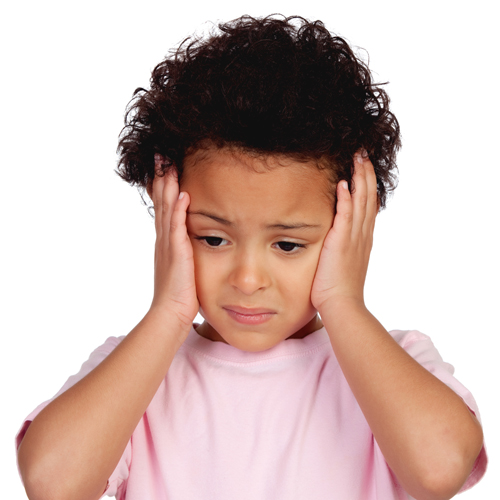Inflammation is Associated with Cognitive Dysfunction in Children with Bipolar Disorder
Researcher Ben Goldstein reported at the 2014 meeting of the American Academy of Child and Adolescent Psychiatry that children with bipolar disorder have levels of inflammatory markers in the same range as people with inflammatory illnesses, such as rheumatoid arthritis. In his research, increases in the inflammatory marker c-reactive protein (CRP) occurred in proportion to the severity of manic symptoms in the children.
Goldstein also discussed cognitive dysfunction, which is often seen early in the course of childhood onset bipolar disorder. Goldstein described studies showing that this type of cognitive dysfunction consists of a decrease in reversal learning, a measure of cognitive flexibility. Elevated CRP was significantly associated with deficits in a child’s composite score for reversal learning.
Together these data suggest that inflammation could play a role in disease disability and cognitive dysfunction in childhood bipolar disorder.
Childhood Maltreatment Leads to Inflammation and Depression in Adulthood
Researcher Andrea Danese discussed the influence of childhood maltreatment on inflammation in a symposium at the 2014 meeting of the American Academy of Child and Adolescent Psychiatry. Danese indicated that inflammation is part of the normal immune system, which includes the blood brain barrier, recognition of self- versus non-self proteins, activation of cytokines and endothelial cells, and response by phagocytes and acute phase proteins. In an acute phase inflammatory response, the liver secretes proteins including c-reactive protein (CRP) and fibrinogen into the blood, where their levels can be measured.
Normal amounts of inflammation can be protective, while excessive or persistent inflammation can be damaging and pathological. The inflammatory cytokines interferon gamma and tumor necrosis factor (TNF alpha) induce an enzyme called indoleamine oxidase (IDO) that shunts the amino acid tryptophan away from its normal path, which yields serotonin, so that it instead yields kynurenine and then kynurenic acid, which inhibits the action of glutamate at NMDA receptors. Kynurenine can also be hydroxylated and turned into quinolinic acid, which activates glutamate NMDA receptors and causes toxicity.
In addition, inflammatory cytokines such as interleukin six (Il-6) can cross the blood brain barrier and directly influence neurotransmission. Meta-analyses have shown that inflammatory markers CRP, IL-6, IL-1, and IL-1 Ra all increase significantly in depression. A direct demonstration of the relationship between inflammation and depression is the finding that when hepatitis C is treated using the inflammatory treatment interferon gamma, there is about a 30% incidence of depression, which responds to the antidepressant paroxetine.
Stress can also increase the activity of the sympathetic nervous system, driving inflammation, and decrease parasympathetic activity, resulting in further inflammation. In addition, glucocorticoid receptor resistance can develop, enhancing depression, and increasing inflammation. Thus there are multiple ways inflammation can develop.
Danese described a study from New Zealand in which 1000 participants were observed over several decades—from childhood through age 38. The small percentage of participants who experienced maltreatment as children (aged three to eleven) showed a linear increase in CRP in adulthood as a function of their histories of previous child maltreatment. The maltreatment included parental rejection in 14%, sexual abuse in 12%, harsh discipline in 10%, changing caretakers in 6%, and physical abuse in 4%. Childhood maltreatment was also associated with some unfortunate outcomes in adulthood, including lower socioeconomic status, more major depression, more persistent depression, more cardiovascular risk, and more smoking. In other studies, Danese found that compared with controls, patients with depression alone, and patients with maltreatment alone, a greater number of patients with both depression and maltreatment (about 30%) had elevated CRP.
Danese noted that in a study by Ford et al. (2004), recurrent depressions, but not single depressions, were also significantly associated with increased CRP. In a meta-analysis by Nanni et al. in the American Journal of Psychiatry in 2012, Danese and colleagues found that across multiple studies, childhood maltreatment was associated with a twofold increase in the incidence of depression and a twofold increase in the persistence of depression (chronic depression or treatment resistance). The traditional optimal treatment for depression, combined psychotherapy and pharmacotherapy, was also significantly less effective in those with histories of childhood maltreatment. However, psychotherapy alone was equally effective in those with and without childhood maltreatment.
Together these data suggest that childhood maltreatment, partly through an inflammatory pathway, results in multiple difficulties in adulthood, including depression and treatment resistance. These data speak to the importance of attempting to prevent maltreatment in the first place, and ameliorating its consequences should it occur.
Editor’s Note: In a 2014 article in the Journal of Nervous and Mental Disorders, this editor Robert Post and colleagues reported that childhood adversity (verbal, physical, or sexual abuse) is associated with increases in medical comorbidities in adult patients with bipolar illness, and it is likely that inflammation could play a role in some of these medical conditions.
Depression in Children with Inflammatory Bowel Disease
 The incidence of irritable bowel disease has been increasing in recent years as obesity has increased. At a symposium at the 2014 meeting of the American Academy of Child and Adolescent Psychiatry, researcher Eva Szigethy discussed depression in inflammatory bowel disease, which most often involves Crohn’s disease or ulcerative colitis. These conditions are associated with increased levels of inflammatory markers such as interleukin 1 (IL-1), interleukin 6 (IL-6), and TNF alpha, and these in turn induce the acute phase reactive protein called c-reactive protein (CRP). The interleukins peak in the first 12 hours after an inflammatory challenge and CRP peaks at 48 hours and returns to normal at 120 hours. Il-6 is most closely associated with the somatic symptoms of inflammation, including depression, fatigue, loss of appetite, and decreased sleep, while TNF alpha is associated with non-somatic symptoms, such as irritability.
The incidence of irritable bowel disease has been increasing in recent years as obesity has increased. At a symposium at the 2014 meeting of the American Academy of Child and Adolescent Psychiatry, researcher Eva Szigethy discussed depression in inflammatory bowel disease, which most often involves Crohn’s disease or ulcerative colitis. These conditions are associated with increased levels of inflammatory markers such as interleukin 1 (IL-1), interleukin 6 (IL-6), and TNF alpha, and these in turn induce the acute phase reactive protein called c-reactive protein (CRP). The interleukins peak in the first 12 hours after an inflammatory challenge and CRP peaks at 48 hours and returns to normal at 120 hours. Il-6 is most closely associated with the somatic symptoms of inflammation, including depression, fatigue, loss of appetite, and decreased sleep, while TNF alpha is associated with non-somatic symptoms, such as irritability.
Szigethy found that in a randomized trial of cognitive behavior therapy versus supportive therapy in children with inflammatory bowel disease, inflammatory activity decreased significantly with cognitive behavioral therapy, and the therapy particularly helped the somatic symptoms of fatigue, sleep disorder, anhedonia (loss of interest in activities once enjoyed), appetite suppression, and mood dysregulation. In contrast, when antidepressants are given to those with inflammatory bowel disease, the drugs are not particularly helpful for these somatic symptoms. Inflammatory bowel diseases are treated with steroids in 21% of patients and with a genetically engineered drug called infliximab in 30%. Adding cognitive behavioral therapy to the regimen decreases CRP and red cell sedimentation rate, an associated measure of inflammation.
The discussant of the symposium on inflammation, Frank Lotrich, described how inflammation alters sleep, and this appeared to interact with genetic risk of illness. For example, those with certain genetic variations (the short SS allele of the serotonin transporter and the val-66-met allele of proBDNF) were most likely to experience sleep disturbance following treatment with interferon gamma, a treatment that fights the virus that causes Hepatitis C, creating inflammation in the process. Interferon gamma causes depression in about one-third of the patients who take it.
Lotrich pointed out that low levels of omega-3 fatty acids are associated with increased irritability and anger, and this is related to the presence of the A allele of TNF alpha. TNF alpha is also closely linked with irritability and anger, suggesting the possible benefits of omega-3 fatty acid supplementation to target irritability and anger more selectively. This would be consistent with the data of researcher Mary A. Fristad.
Il-6 is closely associated with the somatic symptoms of depression, particularly poor sleep, which is itself associated with increases in depression. This is consistent with inflammation being a marker of poor response to antidepressants; Lotrich noted that the selective serotonin reuptake inhibitors (SSRIs), which help depression, are far more effective against the non-somatic aspects of depression and less effective against low energy, decreased interest, and fatigue. However, extrapolating from the data on inflammatory bowel disease, cognitive behavioral therapy may be most helpful on these somatic symptoms.
Lithium Effective In Adolescent Mania And Increases White Matter Volume
At the 2014 meeting of the American Academy of Child and Adolescent Psychiatry, researcher Adelaine Robb reported that in 81 children with mania (aged 7-17), lithium was superior to placebo in reducing the severity of mania measured on the Young Mania Rating Scale. There had been some debate about the efficacy of lithium in young children with mania, but this study clearly indicates lithium’s effectiveness. The drug is approved by the Federal Drug Administration (FDA) for use in patients with bipolar disorder aged 12 and up.
Another researcher, Vivian Kafrantaris, found that in children who averaged 14.5 years of age, lithium increased the volume of the corpus callosum, a bundle of neural fibers that connects the brain’s right and left hemispheres. Lithium also normalized white matter integrity in other neural fiber tracts—the cingulum bundle and the superior longitudinal fasciculus. The authors concluded that lithium may “facilitate microstructural remodeling of white matter tracts involved in emotional regulation.”
Editor’s Note: There is much research showing that in adults, lithium has positive effects on the brain, including increases in hippocampal and cortical grey matter volume. Now it appears that lithium can improve white matter integrity in the developing brain as well.
Multivitamin and Mineral Preparations for Childhood Bipolar Disorder
 Researcher Charles Popper gave a talk at the 2014 meeting of the American Academy of Child and Adolescent Psychiatry on the benefits of nutritional supplements designed to provide multiple vitamins and minerals to children with bipolar disorder and other dyscontrol syndromes, such as attention deficit hyperactivity disorder (ADHD) and oppositional defiant disorder. Popper reviewed the literature on the substantial incidence of vitamin and mineral deficiencies among these children.
Researcher Charles Popper gave a talk at the 2014 meeting of the American Academy of Child and Adolescent Psychiatry on the benefits of nutritional supplements designed to provide multiple vitamins and minerals to children with bipolar disorder and other dyscontrol syndromes, such as attention deficit hyperactivity disorder (ADHD) and oppositional defiant disorder. Popper reviewed the literature on the substantial incidence of vitamin and mineral deficiencies among these children.
A modicum of data support the effectiveness of supplements for children with these disorders. One of these supplements is called EMPowerPlus and is sold online. It is moderately expensive and must be given under the supervision of a knowledgeable treating physician. While it is relatively safe in medication-free children, Popper says it can exacerbate withdrawal reactions from some psychotropic medications.
In addition, EMPowerPlus greatly increases lithium-related side effects, in patients taking lithium, the dose must be reduced to about one-tenth of a normal dose for those who are adding EMPowerPlus.
Popper and another researcher, Mary Fristad, have both seen excellent responses to this type of supplementation in children with bipolar disorder who have been unresponsive to more traditional drugs.
In another study by Rita Aouad et al., 72.3% of 980 children with a variety of psychiatric diagnoses had insufficient vitamin D levels (values < 30 nanograms/ml) and 26.7% had vitamin D deficiency (values < 20 nanograms/ml). These data support the rationale for vitamin D supplementation, especially in those who have low levels to start with.
Differentiating ADHD and Bipolar Disorder
Three articles in the September 2014 issue of the journal Psychiatric Annals (Volume 44 Issue 9) discussed differentiating pediatric bipolar disorder from attention deficit hyperactivity disorder (ADHD). The first article, by Regina Sala et al., said that reasons to suspect bipolar disorder in a child with ADHD include:
- The ADHD symptoms appear for the first time after age 12.
- The ADHD symptoms appear abruptly in an otherwise healthy child.
- The ADHD symptoms initially responded to stimulnts and then did not.
- The ADHD symptoms come and go and occur with mood changes.
- A child with ADHD begins to have periods of exaggerated elation, grandiosity, depression, decreased need for sleep, or inappropriate sexual behaviors.
- A child with ADHD has recurring severe mood swings, temper outbursts, or rages.
- A child with ADHD has hallucinations or delusions.
- A child with ADHD has a strong family history of bipolar disorder in his or her family, particularly if the child does not respond to appropriate ADHD treatments.
The second article, by this editor Robert Post, Robert Findling, and David Luckenbaugh, emphasized the greater severity and number of symptoms in childhood onset bipolar disorder versus ADHD. Children who would later develop bipolar disorder had brief and extended periods of mood elevation and decreased sleep in the early years of their lives. These, along with pressured speech, racing thoughts, bizarre behavior, and grandiose or delusional symptoms emerged differentially from age three onward. In contrast, the typical symptoms of ADHD such as hyperactivity, impulsivity, and decreased attention were equal in both diagnoses.
In the third article, Mai Uchida et al. emphasized the utility of a family history of bipolar disorder as a risk factor. Moreover, a child with depression plus ADHD is at increased risk for a switch into mania on antidepressants if there is a family history of mood disorders, emotional and behavioral dysregulation, subthreshold mania symptoms, or psychosis.
The differential diagnosis of ADHD versus bipolar disorder (with or without comorbid ADHD) is critical, as drug treatment of these disorders is completely different.
Bipolar disorder is treated with atypical antipyschotics; anticonvulsant mood stabilizers, such as valproate, carbamazepine, or lamotrigine; and lithium. Only once mood is stabilized should small doses of stimulants be added to treat residual ADHD symptoms.
ADHD, conversely, is treated with short- or long-acting stimulants such as amphetamine or methylphenidate from the onset, and these may be augmented by the noradrenergic alpha-2 agonists guanfacine or clonidine. The selective noradrenergic re-uptake inhibitor atomoxetine is also approved by the Federal Drug Administration (FDA) for the treatment of ADHD. The dopamine-active drug bupropion and the anti-narcolepsy drugs modafinil and armodafinil have mild anti-ADHD effects but have not been FDA-approved for that purpose.
A Symposium on High Risk Studies: Offspring of Parents with Bipolar Disorder
In a symposium at the 2014 meeting of the International College of Neuropsychopharmacology, four researchers shared insights on children who are at higher risk for bipolar disorder because they have a parent with the disorder.
Researcher John Nurnberger has been studying 350 children of parents with bipolar disorder in the US and 141 control children of parents with no major psychiatric disorder, following the participants into adolescence. He found a major affective disorder in 23.4% of the children with parents who have bipolar disorder and 4.4% of the controls. Of the at-risk children, 8.5% had a bipolar diagnosis versus 0% of the controls.
Nurnberger found that disruptive behavior disorders preceded the onset of mood disorders, as did anxiety disorders. These diagnoses predicted the later onset of bipolar disorder in the at-risk children, but not in the controls. A mood disorder in early adolescence predicted a substance abuse disorder later in adolescence among those at risk.
In genome-wide association studies, the genes CACNA1C and ODZ4 are consistently associated with risk of bipolar disorder, but with a very small effect size. Therefore, Nurnberger used 33 different gene variants to generate a total risk score and found that this measure was modestly effective in identifying relative risk of developing bipolar disorder. He hopes that using this improved risk calculation along with family history and clinical variables will allow better prediction of the risk of bipolar onset in the near future.
Researcher Ann Duffy reported on her Canadian studies of children who have a parent with bipolar disorder and thus are at high risk for developing the disorder. In contrast to the studies of Nurnberger et al. and many others in American patients, she found almost no childhood onset of bipolar disorder before late adolescence or early adulthood. She found that anxiety disorders emerge first, followed by depression, and then only much later bipolar disorder. Bipolar disorder occurred with comorbid substance abuse disorders in only about 10-20% of cases in 1975, but substance abuse increased to 50% of bipolar cases in 2005. The incidence of comorbid substance disorder and the year at observation correlated strongly, indicating a trend toward increased substance abuse over the 30-year period.
Duffy found that having parents who were ill as opposed to recovered was associated with a more rapid onset of mood disorder in the offspring, usually in early adulthood. Duffy emphasized the need to intervene earlier in children of parents with bipolar disorder, but this is rarely done in clinical practice. Read more
Korean Study of Mental Disorders in Children of Bipolar Parents
Korea, like the US, has a moderate incidence of childhood-onset bipolar disorder among children who are at high risk because they have a parent with bipolar disorder. In a recent study by Young-Sun Cho et al. presented at the 2014 meeting of the International College of Neuropsychopharmacology (CINP), 59 out of 100 children with a parent who had been diagnosed with bipolar disorder met the criteria for a mental disorder themselves.
Mood disorders were most common. Of the 59 children with mental disorders, 22 were diagnosed with bipolar disorder, and 16 were diagnosed with a depressive disorder. Others included four with attention deficit hyperactivity disorder (ADHD), four with an anxiety disorder, two with disruptive behavior disorders, one with a tic disorder, one with an autistic disorder, and one with schizophrenia and an anxiety disorder.
Editor’s Note: In contrast to studies in Germany, Switzerland, the Netherlands, and Canada, where few children are diagnosed with bipolar disorders (even among those who are at high risk because of a family history of bipolar disorder), 22% of high-risk children in Korea were diagnosed with bipolar disorder. This is comparable to or higher than rates at which high-risk children in the US are diagnosed with bipolar disorder. Studies from both the Bipolar Collaborative Network (in which this editor Robert Post is an investigator) and researcher Boris Birmaher et al. found that parents with bipolar disorder often had a variety of other disorders, such as anxiety, alcohol abuse, or substance abuse. These other illnesses also increase the risk of early-onset bipolar disorder in offspring, and this may account for the higher incidence of early-onset bipolar disorder among high-risk children in the US.
International Bipolar Foundation Advocates for Prompt Treatment of Children
 Muffy Walker gave an inspirational talk at the 2014 meeting of the International Society for Bipolar Disorders about the International Bipolar Foundation (IBPF, formerly known as the California Bipolar Foundation) she started with three other mothers of children with bipolar disorder. The organization advocates for better understanding and treatment of the illness in children. Treatment is too often delayed and insufficient, as was the case with Walker’s son, who started having trouble at age four and was diagnosed with post-traumatic stress disorder (PTSD), oppositional defiant disorder (ODD), attention-deficit hyperactivity disorder (ADHD), and conduct disorder (CD) before he became severely manic while taking the antidepressant fluoxetine (Prozac). The foundation has a monthly e-newsletter. Their website is http://ibpf.org.
Muffy Walker gave an inspirational talk at the 2014 meeting of the International Society for Bipolar Disorders about the International Bipolar Foundation (IBPF, formerly known as the California Bipolar Foundation) she started with three other mothers of children with bipolar disorder. The organization advocates for better understanding and treatment of the illness in children. Treatment is too often delayed and insufficient, as was the case with Walker’s son, who started having trouble at age four and was diagnosed with post-traumatic stress disorder (PTSD), oppositional defiant disorder (ODD), attention-deficit hyperactivity disorder (ADHD), and conduct disorder (CD) before he became severely manic while taking the antidepressant fluoxetine (Prozac). The foundation has a monthly e-newsletter. Their website is http://ibpf.org.
Differentiating Bipolar Disorder and ADHD in Childhood
At the 2014 meeting of the International Society for Bipolar Disorders, researcher B.N. Kim discussed symptoms that could distinguish between bipolar disorder and attention deficit hyperactivity disorder (ADHD) in childhood. Both disorders are characterized by decreased attention, concentration, and frustration tolerance, and increased activity, impulsiveness, and irritability.
Kim shared several differential symptoms that are more indicative of a bipolar diagnosis and that are inconsistent with a simple ADHD diagnosis (and this editor Robert Post has added several more). Signs and symptoms that suggest bipolar disorder and not ADHD include: decreased need for sleep, brief and extended periods of euphoria, hypersexuality, delusions, hallucinations, suicidal or homicidal impulses and/or actions, extreme aggression, and multiple areas of extreme behavioral dyscontrol. ADHD, on the other hand, is characterized by more difficulty focusing attention, and by less extreme symptoms in general.








